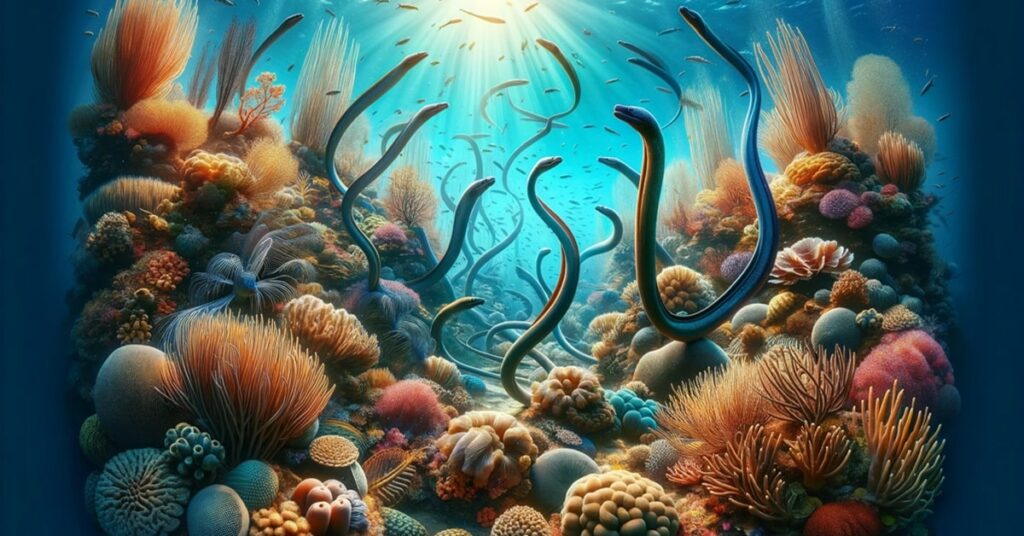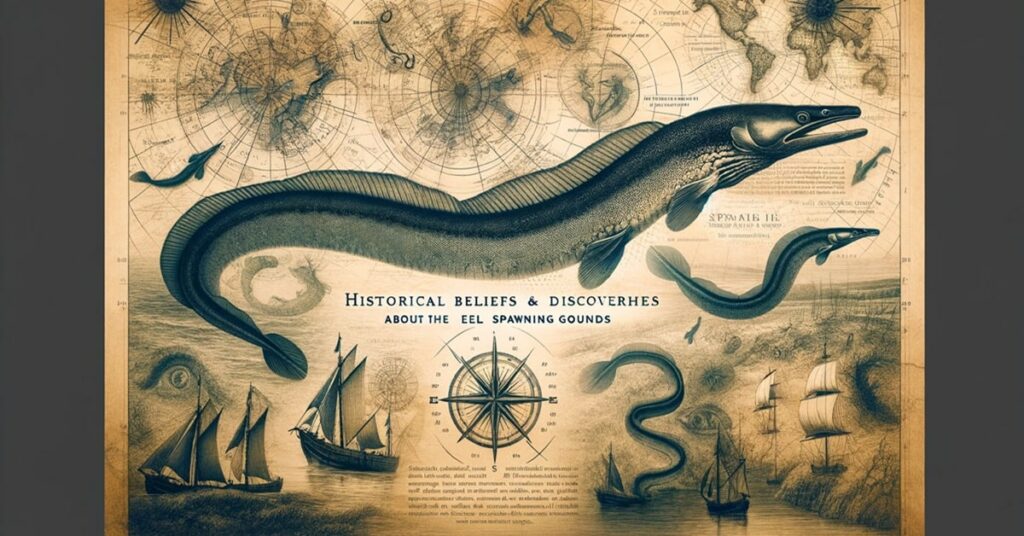Unraveling the Enigmatic Life of Eels
Eels, with their serpentine bodies and secretive nature, have long captivated the curiosity of both scientists and the public alike. Yet, one of the most fascinating aspects of these creatures remains shrouded in mystery: their method of reproduction. The enigmatic reproductive journey of eels, particularly of species like the European eel (Anguilla anguilla) and the American eel (Anguilla rostrata), has puzzled researchers for centuries.
Despite their common presence in both fresh and marine waters across the globe, the precise details of how eels reproduce remain elusive. This introductory section aims to shed light on what is known about eel reproduction, the significance of uncovering these secrets, and why the reproductive cycle of eels continues to be one of the aquatic world’s most enduring mysteries.
As we delve into the biology and lifecycle of eels, we explore not just the scientific quest to understand these elusive creatures but also the broader implications of their mysterious lives. From their impact on ecosystems to their cultural and economic importance around the world, eels represent a fascinating nexus of natural wonder and human interest. Join us as we embark on a journey to uncover the hidden world of eel reproduction, a quest that takes us from the depths of the oceans to the forefront of scientific research.
Understanding Eel Biology
Basic Biology of Eels
Eels possess a fascinating anatomy tailored for their unique lifecycle, with elongated bodies that contribute significantly to their reproductive processes. Key reproductive organs mature remarkably late in their life cycle, a trait that has intrigued scientists. Their body structure, including a specialized vascular system, supports their long migrations essential for reproduction.
Distinguishing between freshwater and saltwater eels is crucial, as their habitats greatly influence their life and reproductive cycles. Freshwater eels, like the Anguilla anguilla, migrate to the sea to spawn, while many saltwater species spend their entire lifecycle in marine environments, showcasing diverse reproductive strategies.
The Lifecycle of an Eel
The eel’s lifecycle begins as a leptocephalus (larva), drifting in ocean currents for months or even years before metamorphosing into glass eels and then elvers as they approach freshwater or coastal habitats. This remarkable transformation highlights their adaptability and the complexity of their lifecycle.
Each stage of an eel’s life, from larva to adult, is characterized by specific behaviors and adaptations, such as the dramatic migration of mature eels back to their spawning grounds in the Sargasso Sea. These migrations are a testament to the eels’ remarkable navigational skills and their intrinsic biological drive to reproduce, underscoring the resilience and complexity of these enigmatic creatures.
How Do Eels Reproduce?
Journey to the Spawning Grounds
Eels begin their reproductive life cycle by embarking on a remarkable migration. Species such as the European eel travel vast distances to reach their spawning grounds, a perilous journey fraught with transformation and adaptation.
The Act of Spawning
Once at the spawning grounds, eels engage in external fertilization, a crucial phase in their lifecycle. Females release millions of eggs into the ocean currents, which are then fertilized by the males in the open sea.
The Larval Phase and Return Migration
The next phase of eel reproduction unfolds as eggs hatch into leptocephali. These transparent larvae embark on a multi-year journey back to coastal areas, transforming into glass eels and eventually into young eels, or elvers, ready to start the cycle anew.
Synchronicity with Nature
The timing of the eel’s reproductive cycle is meticulously aligned with lunar and seasonal cycles, showcasing their deep connection with natural rhythms.
Conservation Implications
Understanding the nuances of eel reproduction is critical for the conservation of these mysterious creatures. As they face numerous threats, knowledge of their reproduction is key to their survival.
The Reproductive Journey
The Bermuda Triangle Connection
The Bermuda Triangle has long been a subject of fascination, not just for its mysterious disappearances but also for its speculative connection to eel reproduction. Some theories suggest that the magnetic anomalies associated with the Bermuda Triangle could influence the migratory paths of eels, particularly as they journey to their spawning grounds. These hypotheses propose that eels might be using geomagnetic cues for navigation, leading them through this enigmatic region.
Scientific investigations into these claims have sought to understand the complex behaviors of eels, especially their remarkable navigational skills. While research has yet to definitively link eel spawning activities to the Bermuda Triangle directly, ongoing studies continue to explore the potential impacts of geomagnetic fields on eel migration, aiming to unravel the mysteries of their reproductive journey.
The Spawning Grounds Mystery
For centuries, the exact location of eel spawning grounds remained one of the natural world’s greatest enigmas. Historical beliefs suggested that eels spawned in the Sargasso Sea, a hypothesis only confirmed in recent decades through scientific exploration. The vast, open nature of the Sargasso Sea, combined with the eels’ secretive spawning behavior, made this discovery a significant milestone in marine biology.
Modern technology, including satellite tracking and genetic testing, has revolutionized our understanding of eel migration patterns. These tools have allowed scientists to track eel movements across vast ocean distances, providing invaluable insights into their life cycle, spawning behaviors, and the environmental challenges they face. Through these advancements, we are gradually peeling back the layers of mystery surrounding the reproductive journey of eels, offering hope for their conservation and future study.
Challenges in Understanding Eel Reproduction
Difficulties in Captivity Breeding
Breeding eels in captivity poses significant challenges, primarily due to their complex lifecycle and the late development of their reproductive organs. Eels spend a considerable portion of their lives in a state not conducive to spawning, which, combined with their long migratory patterns, complicates captive breeding efforts. These factors have historically hindered scientists’ ability to observe and understand the full reproductive process of eels under controlled conditions.
Recent breakthroughs, however, have begun to shed light on these mysteries. Advances in aquaculture techniques and hormonal treatments have shown promise in inducing reproduction in captivity, marking significant progress in eel research. These developments not only offer hope for unlocking the secrets of eel reproduction but also for the conservation of species at risk of overfishing and habitat loss.
Environmental Impacts on Eel Reproduction
The reproductive success of eels is intricately linked to environmental conditions, making them particularly vulnerable to pollution and climate change. Changes in water temperature, salinity, and habitat destruction have all been shown to negatively impact eel populations, further complicating their already mysterious reproduction process.
Conservation efforts are crucial for protecting eel habitats and ensuring the sustainability of their populations. Initiatives such as habitat restoration, pollution control, and sustainable fishing practices are being implemented to mitigate the adverse effects of environmental changes. Through these efforts, alongside continued research into their reproductive biology, there is hope for the preservation of these enigmatic creatures for future generations.
Cultural and Economic Importance of Eels
Eels in Cuisine
Eels hold a significant place in global cuisines, with Japanese unagi (grilled eel) and Italian eel dishes standing out for their unique flavors and cultural importance. In Japan, unagi is a delicacy often served over rice and considered a luxury dish, while in Italy, eels are traditionally prepared during the Christmas season. The demand for eel dishes has led to the development of sustainable fishing and aquaculture practices, aimed at maintaining eel populations while meeting culinary needs.
Eels in Popular Culture
Eels feature prominently in mythology, folklore, and modern media across various cultures, symbolizing everything from good fortune to the mysteries of the natural world. Their unique characteristics and mysterious life cycle have inspired numerous stories and legends. In recent years, efforts have been made to use popular culture as a tool for eel conservation, educating the public about the ecological importance of eels and the challenges they face, thereby fostering a greater appreciation and a call to action for their preservation.
Conclusion
Our exploration into the enigmatic world of eel reproduction has uncovered the fascinating complexities of these creatures. From the intricate details of their anatomy to their mysterious life cycles and the challenges faced in understanding their reproduction, eels continue to intrigue and mystify. The importance of continued research cannot be overstated, as it holds the key to unraveling these mysteries and ensuring the conservation of these unique creatures. Public interest and engagement are equally crucial, fostering a collective effort to protect and preserve the eel populations for future generations. As we say goodbye, life’s cycle continues unabated, much like the fascinating reproduction process of eels.
FAQs
Q1: Why is eel reproduction a mystery?
Eel reproduction remains a mystery mainly due to their complex lifecycle and elusive spawning behavior. Scientists have struggled to observe these events in the wild, and eels’ late sexual maturity adds to the difficulty.
Q2: Can eels reproduce in captivity?
Historically, reproducing eels in captivity has been challenging due to their unique reproductive cycle. However, recent advances in aquaculture and hormonal treatments have shown promise in inducing spawning under controlled conditions.
Q3: What is known about the spawning grounds of eels?
The spawning grounds of some eel species, such as the European and American eels, are believed to be in the Sargasso Sea. However, the exact locations and conditions of these spawning events remain largely unknown, with much of the information based on larval eel distributions and migrations.
In the same way we marvel at the mysterious journey of eels, other animals also lead fascinating lives worth exploring. Learn how the care and environment influence the lifespan of horses, unveiling another remarkable story of nature.
![How Do Eels Reproduce? [Unexpected Discovery] Close-up image of an eel's head, focusing on its eye and mouth, showcasing the detailed texture of its skin in a dark underwater setting.](https://alohado.com/wp-content/uploads/2024/03/eel-face-1024x536.jpg)




